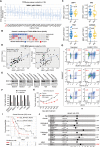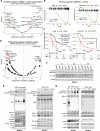MEK1 drives oncogenic signaling and interacts with PARP1 for genomic and metabolic homeostasis in malignant pleural mesothelioma
- PMID: 36765038
- PMCID: PMC9918536
- DOI: 10.1038/s41420-023-01307-2
MEK1 drives oncogenic signaling and interacts with PARP1 for genomic and metabolic homeostasis in malignant pleural mesothelioma
Abstract
Malignant pleural mesothelioma (MPM) is a lethal malignancy etiologically caused by asbestos exposure, for which there are few effective treatment options. Although asbestos carcinogenesis is associated with reactive oxygen species (ROS), the bona fide oncogenic signaling pathways that regulate ROS homeostasis and bypass ROS-evoked apoptosis in MPM are poorly understood. In this study, we demonstrate that the mitogen-activated protein kinase (MAPK) pathway RAS-RAF-MEK-ERK is hyperactive and a molecular driver of MPM, independent of histological subtypes and genetic heterogeneity. Suppression of MAPK signaling by clinically approved MEK inhibitors (MEKi) elicits PARP1 to protect MPM cells from the cytotoxic effects of MAPK pathway blockage. Mechanistically, MEKi induces impairment of homologous recombination (HR) repair proficiency and mitochondrial metabolic activity, which is counterbalanced by pleiotropic PARP1. Consequently, the combination of MEK with PARP inhibitors enhances apoptotic cell death in vitro and in vivo that occurs through coordinated upregulation of cytotoxic ROS in MPM cells, suggesting a mechanism-based, readily translatable strategy to treat this daunting disease. Collectively, our studies uncover a previously unrecognized scenario that hyperactivation of the MAPK pathway is an essential feature of MPM and provide unprecedented evidence that MAPK signaling cooperates with PARP1 to homeostatically maintain ROS levels and escape ROS-mediated apoptosis.
© 2023. The Author(s).
Conflict of interest statement
The authors declare no competing interests.
Figures







Similar articles
-
Synthetic lethality in malignant pleural mesothelioma with PARP1 inhibition.Cancer Chemother Pharmacol. 2017 Oct;80(4):861-867. doi: 10.1007/s00280-017-3401-y. Epub 2017 Jul 29. Cancer Chemother Pharmacol. 2017. PMID: 28756516 Free PMC article.
-
Cancer-Associated Fibroblasts Regulate Kinase Activity in Mesothelioma Cell Lines via Paracrine Signaling and Thereby Dictate Cell Faith and Behavior.Int J Mol Sci. 2022 Mar 18;23(6):3278. doi: 10.3390/ijms23063278. Int J Mol Sci. 2022. PMID: 35328699 Free PMC article.
-
Diarachidonoylphosphoethanolamine induces apoptosis of malignant pleural mesothelioma cells through a Trx/ASK1/p38 MAPK pathway.J Pharmacol Sci. 2015 Nov;129(3):160-8. doi: 10.1016/j.jphs.2015.10.003. Epub 2015 Oct 23. J Pharmacol Sci. 2015. PMID: 26588871
-
Heterogeneous Contributing Factors in MPM Disease Development and Progression: Biological Advances and Clinical Implications.Int J Mol Sci. 2018 Jan 13;19(1):238. doi: 10.3390/ijms19010238. Int J Mol Sci. 2018. PMID: 29342862 Free PMC article. Review.
-
The role of BCL-2 family proteins and therapeutic potential of BH3-mimetics in malignant pleural mesothelioma.Expert Rev Anticancer Ther. 2021 Apr;21(4):413-424. doi: 10.1080/14737140.2021.1856660. Epub 2020 Dec 10. Expert Rev Anticancer Ther. 2021. PMID: 33238762 Review.
Cited by
-
Malignant mesothelioma tumours: molecular pathogenesis, diagnosis, and therapies accompanying clinical studies.Front Oncol. 2023 Jul 4;13:1204722. doi: 10.3389/fonc.2023.1204722. eCollection 2023. Front Oncol. 2023. PMID: 37469419 Free PMC article. Review.
-
Combining Copper and Zinc into a Biosensor for Anti-Chemoresistance and Achieving Osteosarcoma Therapeutic Efficacy.Molecules. 2023 Mar 24;28(7):2920. doi: 10.3390/molecules28072920. Molecules. 2023. PMID: 37049685 Free PMC article. Review.
-
Malignant peritoneal mesothelioma interactome with 417 novel protein-protein interactions.BJC Rep. 2024 May 24;2(1):42. doi: 10.1038/s44276-024-00062-w. BJC Rep. 2024. PMID: 39516360 Free PMC article.
-
BAP1 Deficiency Inflames the Tumor Immune Microenvironment and Is a Candidate Biomarker for Immunotherapy Response in Malignant Pleural Mesothelioma.JTO Clin Res Rep. 2024 Mar 29;5(5):100672. doi: 10.1016/j.jtocrr.2024.100672. eCollection 2024 May. JTO Clin Res Rep. 2024. PMID: 38715965 Free PMC article.
-
Inhibition of LDHB triggers DNA damage and increases cisplatin sensitivity in pleural mesothelioma.Oncogenesis. 2025 Aug 11;14(1):28. doi: 10.1038/s41389-025-00571-4. Oncogenesis. 2025. PMID: 40790017 Free PMC article.
References
-
- Janes SM, Alrifai D, Fennell DA. Perspectives on the treatment of malignant pleural mesothelioma. New Engl J Med. 2021;385:1207–18. - PubMed
Grants and funding
LinkOut - more resources
Full Text Sources
Research Materials
Miscellaneous

